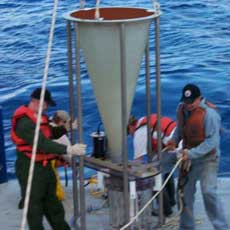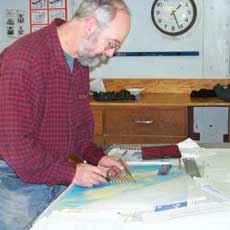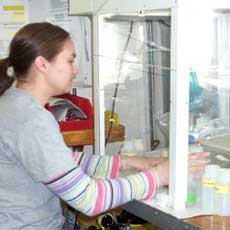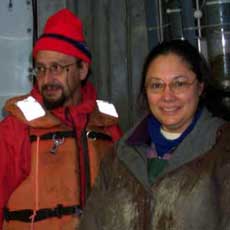


The Project
|
Daily JournalDecember 9, 2004: Life in the Lab —
|
Retrieving the sediment sample
Chief Scientist Bob Collier plotting the next way station.
Processing the CTD water sample
Processing the multicore sample |
Background: What and Why?
One of the major objectives of the New Horizon 2004 expedition was to recover the sediment traps that had been collecting particles over the past year. Two other instruments were used to routinely retrieve information, the CTD and the multicore. (See prior journal photos for pictures of the CTD). The CTD will be deployed (put into use) 15 times and the multicore, 30 times. These instruments will take half the samples from the south San Clemente trench and half from the north San Clemente trench.
THE SEDIMENT TRAP: WHAT IS IT AND WHAT DOES IT DO?
The sediment trap is shaped like a funnel (an upside down cone). Last year, 2 traps were deployed to collect particles that were settling from the surface to the ocean floor. These particles are mostly made up of animal and plant material (organic matter). The samples from the sediment trap are used to quantify (tell how much) barium is settling down from the surface with the organic matter and the amount coming in from the seeps. Barite particles are isolated from the trap and are analyzed to find out where they come from.
THE CTD: WHAT IS IT AND WHAT DOES IT DO?
CTD stands for conductivity, temperature, and depth. This instrument collects water samples and measures water salinity (from conductivity), water temperature, and the depth at which the sample was taken. The CTD has 24 ten liter bottles in which to collect water. The water samples are analyzed to determine the amount of dissolved barium. The CTD sensors also send back information about the amounts of dissolved oxygen and chlorophyll in the water. The CTD also has a transducer that uses sound to measure how far off the bottom the instrument is.
Question 1: What marine animal uses sound to measure distance?
THE MULTICORE:WHAT IS IT AND WHAT DOES IT DO?
The multicore is a pyramid shaped instrument that collects mud samples (sediment) from the ocean floor. Mud is collected from the ocean floor into 8 tubes.
WHAT ARE SCIENTISTS DOING AT THIS SITE?
The San Clemente basin is the site of a cold seep, a place where fluids are flowing out of the ocean floor. This type of activity is unusual. One of the elements contained in the fluids is barium. Scientists are looking for a plume to identify where the seepage is taking place. This is similar to what scientists studying Mt St. Helens or other volcanoes would do. They look for a plume of smoke (in the case of volcanoes) to identify activity.
WHY DO SCIENTISTS WANT TO KNOW ABOUT BARIUM DEPOSITS?
Barium helps us understand the history of the ocean as recorded in sediments. Knowing the history of the ocean helps scientists better predict the future of the ocean. Understanding how oceans have changed in the past can help us predict how global climate change will affect oceans in the future.
Question 2: A famous quote is, "Those who are not familiar with history are doomed to repeat it." What does this mean? Can you think of an example in history (or a personal example) where knowing more history/background information could have helped someone make a better decision?
WHY IS IT IMPORTANT TO PREDICT OCEAN CHANGES?
These changes not only affect life in the ocean, they also affect all life on the planet. Ocean changes will impact the productivity of the ocean resulting in changes in the weather, the oxygen supply, and number of marine life.
Question 3: What are some decisions/choices people can make that will result in a positive (or negative) affect on the planet?
HOW DO SCIENTISTS ANALYZE THE DATA?
WORK ABOARD AND FOLLOW-UP ON SHORE
SAMPLES FROM THE SEDIMENT TRAPS:
The organic material and the barite is put in containers so that it can be sent to on-shore labs to be analyzed.
SAMPLES FROM THE CTD:
On the ship, the water is filtered to remove the particles. The water sample is sent with the computer data on temperature, salinity, and depth to labs on land. Some of the samples are stored so that they can be used by other scientists.
SAMPLES FROM THE MULTICORE:
On board ship, the surface sediments of a portion of the cores are extracted so that they can be measured for barium. The pore water is extracted at various depths in order to understand whether the barium is dissolving, to find out how much is there, to find out what form it's in, and to find out where it's going. Just like with personal finances, you need to know what you have, what's coming in and what's going out. Having a part of this information is not enough. Other cores are archived (filed/stored) in a nationally funded repository (storage place). This repository is like a library. The samples are catalogued according to their characteristics. The samples are available for other scientists doing studies.
Question 4: If at location A the sample contains 1% barium and at location B the sample contains 1% barium, are these sites accumulating barium at the same rate?
BEFORE YOU ANSWER, think of the following situation. Billy Bob and Peggy Sue are both driving home in their own cars from Jim Bob's party. Both Billy Bob and Peggy Sue are pulled over by the state police for driving erratically. If Billy Bob and Peggy Sue both have the same blood alcohol levels (and yes, they are over the limit), did they consume the same amount of alcohol? How does this relate to amounts of barium that might have accumulated at a given location?
Recovering, recording, and analyzing are some of the activities that take place on a daily basis in the science lab. Learning from the ocean's past can help us have a better future.
![]()




